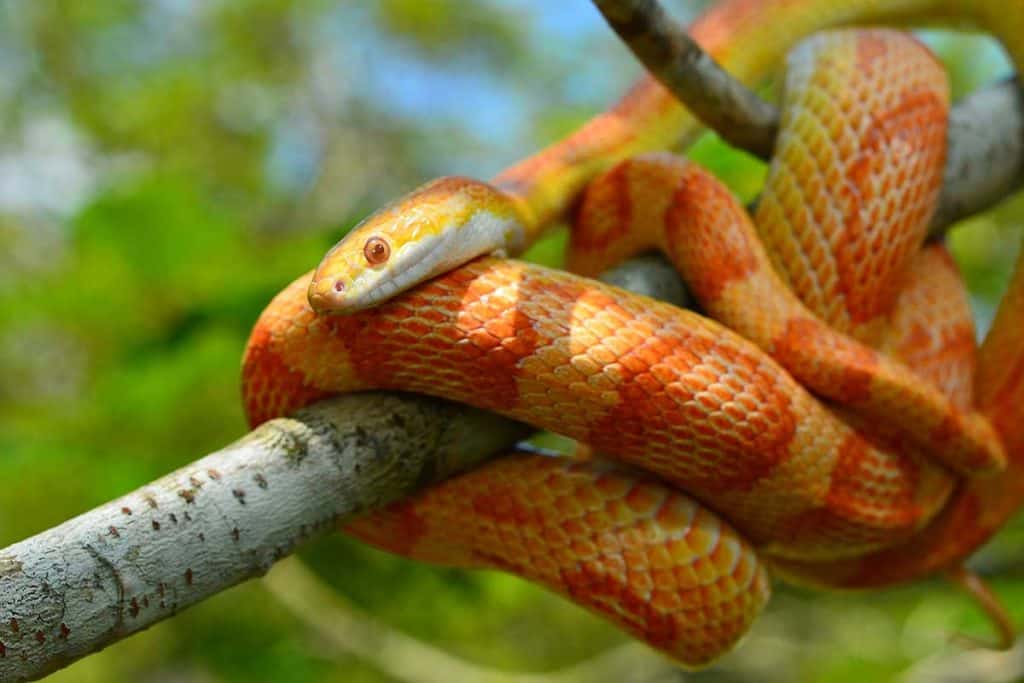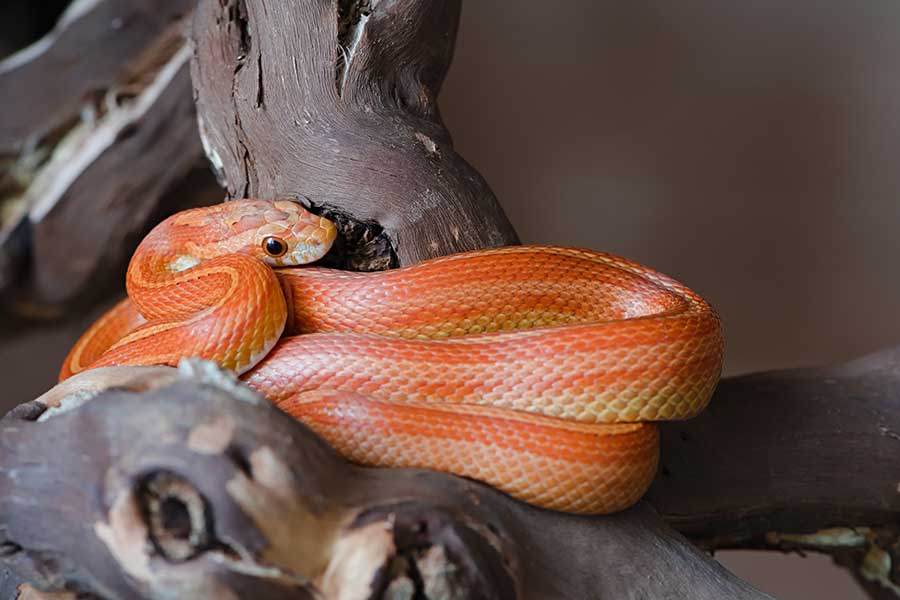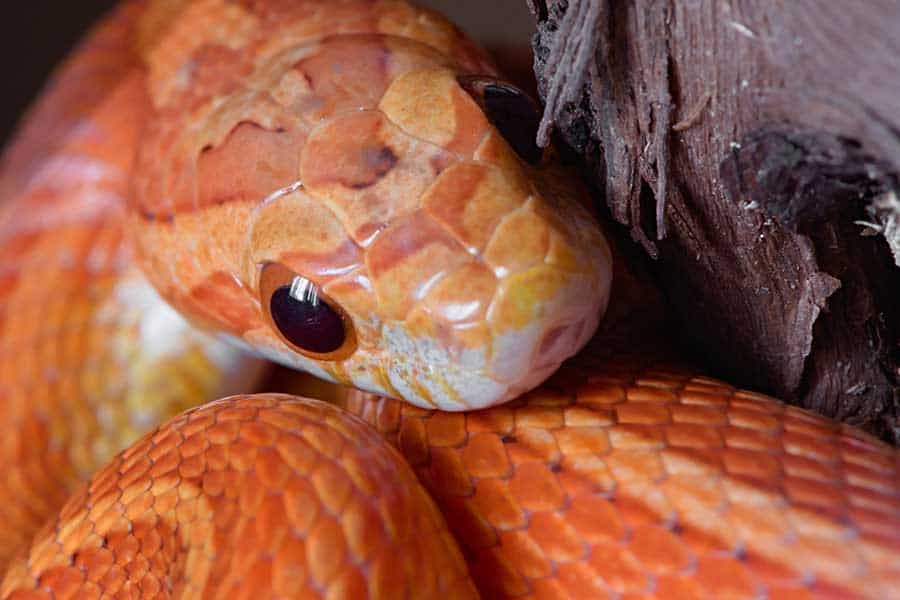If you are in the market for a new pet snake that is very friendly, loves to be handled, and won’t break the bank, then the adorable and docile corn snake is probably a great choice! However, owning a snake is a long-term commitment, so we need to answer the question: how much is a corn snake? Furthermore, how much does it cost to care for one?
Corn snakes are one of the most popular snakes to own as pets. This is because they are a decent size (two to three feet as adults) which makes them easy to handle but not too big that they may scare a newbie snake owner.
Corn snakes also have simple care requirements compared to most reptiles, which brings the cost of owning one down considerably regardless of whether you’re a novice or an expert reptile hobbyist.
Read on to find out exactly the real cost of owning a corn snake!
About the Corn Snake
Corn snakes are actually part of the rat snake family, and they are native to the eastern US! They are especially loved by farmers in North America because they eat mice and rats, which keeps pests under control on farms.
One key reason why corn snakes are so inexpensive is the fact that they are prolific breeders. Most corn snakes lay one clutch of around 15 eggs per year! If the conditions are right, all of those eggs will turn into baby snakes. This makes them widely available in pet shops and from reputable breeders.
In addition to their common nature, they come in a wide range of beautiful morphs. As with all other reptiles, the more complex the morph is, the bigger the price tag.
How Much Is a Corn Snake?
For a normal tan/orange corn snake, the cost can be as little as $30. These snakes can be bought from pet shops or local or online breeders. It is always best to support a breeder over a big box pet shop, as breeders tend to be more knowledgeable and use more ethical breeding practices.
Different morphs can have vastly different prices. The more complicated, rare, and beautiful the morph is, the higher the price will be.
A more common morph such as the hypo het Anery corn snake morph can cost $80. The hypo bloodred motley corn snake morph can cost $225. The amber stripe scaleless corn snake morph can cost $700, and a rare morph such as a scaleless snow hypo corn snake morph can go for $800 or more!
Reach out to different breeders either locally or online and see what corn snakes they have available!
Expenses for Corn Snake’s Enclosure Setup
The real cost of owning a snake will make itself known within the first year. This is when you are going to purchase at least one (if not two or more) enclosures, multiple hides, and water dishes, as your corn snake is going to grow rapidly.
This is also when you will be purchasing the snake itself, as well as lighting, fixtures for your bulbs, thermometers, and a hygrometer. If possible, set up your snake’s enclosure before bringing them home. This way, you’ll be able to do a “test run” of their enclosure setup to make sure the humidity, temperature, substrate, etc. are all correct.
However, after the initial setup is done, you only need to worry about the consumables. This means the initial investment for a corn snake is a bit pricey, but after that, they are fairly inexpensive pets!
Enclosure
Enclosures can range from $70 to $150 for a 20-gallon enclosure, which is the correct size enclosure for a juvenile and young adult.
Adult enclosures should be at least 40 gallons. These can range from $150 to $300 depending on the materials used to make them. 40 to 50-gallon enclosures can be purchased from most big box pet shops and online retailers, but very large enclosures often need to be custom-built.
If you are housing multiple corn snakes together, then you need to increase the minimum enclosure size by at least 10 gallons per snake.
Once you purchase an enclosure for your snake, you should not need to replace it, except to upgrade it to a larger size. Most durable, well-made enclosures rarely break, except if they are dropped.
Substrate
Substrate is the bedding or the “stuff” on the floor of your snake’s enclosure. The substrate needs to be a minimum of two to three inches deep because corn snakes love to burrow! This means they will need more substrate on average than a snake that only needs a shallow layer.
Check out our guide on the best substrate for corn snakes!
Substrate comes in many differently sized bags and containers. Each of these will cover a certain percentage of your corn snake’s enclosure floor. Some are much cheaper than others, and there are many great options on the market to choose from.
For example, 24 quarts of aspen bedding ($12.47) is going to equal 6 gallons, which is more than enough to cover the bottom of your 20-gallon enclosure!
All of the substrate will need to be changed every four to eight weeks depending on the type of substrate you use. If you are diligent in spot cleaning every day, you can stretch this length of time out even further.
Snakes poop and pee, and it needs to be cleaned up quickly to keep the substrate from becoming contaminated.
Decor, Hides, Etc.
Your corn snake needs to have some clutter and ‘decorations’ in its enclosure. These are not only for decorative purposes; they actually perform a very important function. Logs, pipes, coconut shells, foliage, and hides are all there to make your corn snake feel safe and secure.
Your corn snake must have an enclosure setup that helps it reduce its stress levels. Having privacy in the form of plenty of places to hide and explore will make your corn snake feel right at home!
Many of these decorations can be homemade or recycled and cost you $0! Hides can be as simple as plastic containers that are turned over and have a little doorway cut into them. The ones you can buy for as much as look exactly like an upended container anyway!
You can get branches, rocks, and leaves from your garden to use in your corn snake’s enclosure which will cost you $0!
However, if this is the route you want to take, then you will need to spend time sanitizing them and making sure they are safe.
One way to do this is to boil and then dry or bake logs, branches, and leaf litter. The boiling process will get rid of any organisms and chemicals from your garden. It is then necessary to dry the items out completely to prevent them from molding once they are in the enclosure.
Layering fake plants like this pothos vine ($6.50) on the floor is a cheap way to help create an environment where your corn snake will feel sheltered and safe. There are some other very cool-looking hides ($11.99) and decorations that are available online too.
These are mainly part of the initial cost of setting up your enclosure. Once all of your decorations are bought or made, you will only have to buy or make new ones if your corn snake outgrows their hides.
Decorations are not just for show or safety; they also provide your corn snake with its own playground to sniff around and explore. Mental stimulation along with exercise is essential to keeping a corn snake healthy and happy.
Heating
Corn snakes need a constant source of heat because they are ectothermic, which means they cannot control their own body temperature and rely on the environment to help them maintain it and their metabolism.
You can supply heat to your corn snake’s enclosure in one of three main ways.
- You can use an under-tank heating pad like this one from VIVOSUN, which has a built-in thermostat. This is very helpful in controlling your enclosure’s thermal gradient. These heating pads average at around $15 to $30. The bigger it is, the more expensive it will be. These do not need to be purchased regularly and can last a very long time.
- Heating bulbs are another popular method used to heat an enclosure. You would need to buy the lamp’s fixture at a one-off cost of about to , depending on the size of the bulb it is designed to house and any additional features like timers. You will also need to buy bulbs on a semi-regular basis, or every 4 to 6 weeks or so, as they wear out. These bulbs average at around $10 to $15 depending on the wattage needed to heat your snake’s enclosure.
- Another option is to use a heat emitter. These heat emitters average at around $15. They last a very long time and will not need to be replaced often. They only give off heat and no light, but they function like heat bulbs in that they need fixtures to house them and need to be replaced every four to six weeks or so.
If you live in a very cold climate where the room that your corn snake’s enclosure is in gets very cold, then you will need to heat the room as well. Depending on the size of the room, a space heater can cost you to .
Along with a source of heat, you will need a digital
Heating is an important part of your corn snake’s setup because they will die without the correct temperature gradient.
Lighting
Fortunately, corn snakes do not need special UVB lighting like other reptiles since they spend most of their time underground and away from direct sunlight anyway! Other reptiles, such as bearded dragons, need UVB lighting to absorb the
While corn snakes do not need special UVB lighting, they do need a light source. This is so that they can regulate their photocycle. Therefore they need to have a light in their enclosure that is on a 12-hour timer: 12 hours on, 12 hours off. These lights average at about .
However, there are two ways to do away with this cost:
- Use a visible heat source like a basking bulb. You will need to switch this off at night because snakes can see red light and it will interfere with the natural photocycle.
- You can also place your corn snake’s enclosure in a room near a window that receives a decent amount of natural sunlight during the day! It is essential to never put your corn snake’s enclosure in direct, harsh sunlight, though, because the temperatures inside can rise to fatal levels very quickly.
Maintaining Humidity
Maintaining a humidity range of 65% to 75% is essential for your corn snake to be a happy and healthy little noodle. The best way to monitor humidity levels is to use a hygrometer. Hygrometers can sell for anywhere from $10 to $20.
There are two ways that you can maintain your corn snake’s humidity levels.
The first way is to manually mist the enclosure with water every day. For this, you will only need a spray bottle; you can pick one up for as little as $3 to $6 from most shops. I would recommend a continuous spray or mist bottle to make things easier on your hands.
Another way to maintain humidity levels is to install a misting system. A misting or fogging system can cost anywhere from to 0.
How Much Does a Corn Snake Cost to Feed?
Another cost you’ll need to factor into your snake’s care is how much you’ll spend on food and water. Here’s what you need to know about the costs of both.
Water
Snakes get a lot of their water from their food. However, corn snakes do need access to a continuous fresh supply of water in their enclosures. They need a water dish that is heavy-bottomed, so it cannot be tipped over, and non-porous, so it does not interfere with the humidity levels of the enclosure.
You will often find your corn snake taking a cooling bath in its
Food
Fortunately, corn snakes are not overly large snakes, which means they do not need huge amounts of food and are fairly inexpensive to feed.
Corn snakes should be fed prey items that are appropriately sized and ideally frozen/thawed. An appropriately sized prey item should be roughly the same size/width as the largest point of your snake’s head.
A juvenile corn snake should get two appropriately sized prey items (mice or rats) once a week. Mice that are the appropriate size for most corn snakes are usually sold at around $1 per mouse. Once your corn snake grows in size, it may prefer to eat slightly larger prey items. Larger mice and rats are usually only around $2 to $3 each.
This means you can feed your corn snake for as little as $8 to $16 a month!
A way to cut this cost even further is to buy frozen mice in bulk. Buying them in bulk will mean that you’ll cut down on costs for yourself and you will always have mice on hand and never end up in a situation where your snake is out of a meal.
FAQs on Corn Snake Costs
Can I save money by getting an enclosure that will be the right size for an adult and just using it from the time my corn snake is a baby?
It is important to use the correctly sized enclosure for your snake depending on its age and size. Baby and juvenile corn snakes that are put into an adult-sized enclosure can suffer from stress because they feel very vulnerable in large enclosures. Sometimes, this stress can even be enough to kill them or at least shorten their lifespan.
If you cannot afford multiple enclosures and only get the adult-sized one, then make sure your baby or juvenile corn snake can make it from one end of the enclosure to the other completely hidden.
You can do this by putting hides, logs, rocks, branches, and foliage strategically along the floor of the enclosure so your young corn snake always feels secure. You could also potentially block off part of the enclosure until your snake reaches a larger size.
Is it safe to use leftover PVC pipe in my corn snake’s enclosure?
PVC pipe makes an excellent hide for snakes because it is thick enough to dampen sounds and blocks out light, and it is nice and snug so it feels secure.
However, you need to be aware of a few things if you use PVC pipe as a hide:
- Your snake must be able to fit safely inside the pipe. If there is a risk that it will get stuck (especially after it has fed), then the pipe is too narrow and should not be used as a hide.
- You will need to sand down the edges of the pipe that have been cut to make sure there is nothing there that will hook onto your snake’s skin and injure it.
- When you clean out your corn snake’s enclosure, you must remember to clean the inside of the PVC pipe, too.
Can I catch mice and rats to feed my corn snake as a cheaper option to buying them?
While corn snakes eat wild mice and rats when they are in the wild, it is not 100% safe to do so for corn snakes in captivity.
When you catch wild rats and mice, you run the risk of introducing parasites and pesticides to your corn snake. These parasites and pesticides can be incredibly harmful and even fatal.
If you live in a rural area where there are a lot of mice and rats around, then you could catch them, kill them humanely, and freeze them for at least three days. Freezing the caught mice and rats will kill off the parasites, bacteria, and harmful organisms living in the rodents’ guts and on their fur.
Slithering Off…
How much is a corn snake? Well, that all depends on the type of morphs you are looking at as well as how much of their enclosure setup you are wanting to DIY or buy.
Owning a corn snake is not an incredibly expensive endeavor if you plan it carefully. Take into consideration all of the one-off costs, and you can calculate what will be monthly costs, such as food and the cost of electricity and water.
Keeping a log of your spending will also give you a more accurate idea of how much a corn snake costs to keep and help you plan for the future accordingly!




